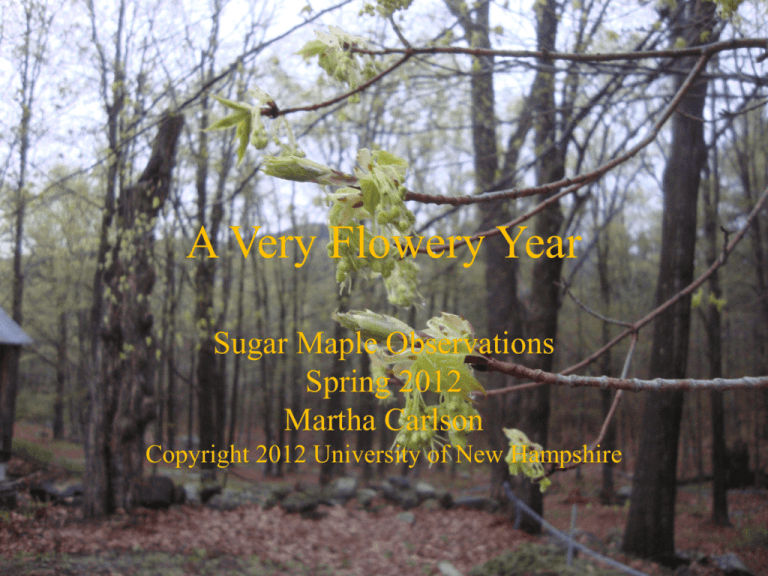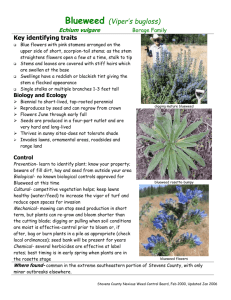A Very Flowery Year - Forest Watch
advertisement

A Very Flowery Year Sugar Maple Observations Spring 2012 Martha Carlson Copyright 2012 University of New Hampshire 2011: Year of Maple Flowers 2011was a year for heavy flowering. Every tree of mature age, 22 years or older, produced a full canopy of pale yellow flowers in late April. Sugar maples produce seeds every 3 to 7 years. Producing viable seeds challenges a tree. It must also produce large healthy leaves to make sugar for wood and twig growth, for wood and roots, and for the biochemicals that protect the tree from insects, fungi and other stresses. Nature prepares healthy trees for this challenge. Maple Watch participants are witnesses to a miracle of Nature. Sugar maples opened as usual in late April but the apical buds were yellow flowers, with tiny leaves around the flowers. The pale gold dominated the trees for two full weeks. Beautiful flowers show stamen, the male pollen containing structures, at the tips of the flowers. Notice the reddish color of protective anthocyanin-filled sepals. Acer saccharum can produce different types of flowers on different parts of its crown. Both male and female organs can be produced in one perfect flower—monoecious (one house). On these flowers, pollen-making stamen appeared to mature earlier than the ovary-containing pistils. Some trees produced all male flowers on some branches, especially lower branches, and female flowers on higher branches. These are polygamo-dioecious, (two houses). The differences assure that pollen from one tree will fertilize flowers on other trees, strengthening the genetic mix. Pollen from drooping stamens on lower branches blew from tree to tree on spring breezes. Pollen rarely travels far. Maple trees are closely related to mother trees on one site. The male flowers contain anthers. These twin structures, like tiny loaves of bread, contain the pollen. The anthers contain pollen Pollen grains look like fat soccer balls when they are healthy and ready to be dispersed. This image was taken with the UNH scanning electron microscope, magnifying the pollen 590 times. Female flowers were located at the base of perfect or monoecious flowers. The female flowers contained paired ovaries which appeared sticky. Why would they need to be sticky? Pollen must stick to them! How does pollen enter the ovary? The twig above shows six samaras and six leaves all grown from one gigantic apical bud. Two additional leaves grew from a lateral (side) bud. The samaras grew and ripened all summer. None fell until mid-September. In 2011, because of the huge numbers of flowers on most trees, some twigs had only two or four leaves, rather than six. Samara facts One side of each samara is almost always empty, even though it has a perfectly formed exterior and interior seed coat. The thick green outer coat protects a delicate white tissue-like inner coat. Within, the maple seed is a tightly rolled ball. Surprisingly, the seed is green. Yes, it contains chlorophyll. It is producing its own sugar from light filtered through the seed coat. A maple seed is protected inside two seed coats A samara seed is tightly curled inside its tissuelike inner coat. The seed is a curl of embryonic root, called the radicle, and two embryonic leaves, the cotyledons. Below, uncurled, the samara has two embryonic leaves and a primordial root. Conclusions Sugar maple seeds were dispersed from the mother trees throughout the fall in 2011. Moist mineral soil is the best seed bed for sugar maple seeds. They develop under a thin layer of soil. Germination begins in early spring and within six weeks, a tiny sugar maple might be found in the shady undergrowth in the sugar bush. Our New Hampshire maples should display dramatic regeneration this spring and summer. All trees in the Maple Watch program showed signs of stress during the 2011 growing season. Leaves were smaller than usual. Tests of leaf reflectance showed lower measurements of chlorophyll, high water stress and early leaf senescence. Many trees dropped their leaves earlier than usual last fall. Buds, developed beside the growing samaras, looked smaller than usual. Tests of sap collected in 2012 may give us clues as to how stressful the 2011 flowers were and how resilient our sugar maples are. Keep your eyes on the buds! Stressed by heavy flowering duties, stressed again in the recent winter by oddly warm temperatures, how will our maple buds open this spring? Email Forest Watch, forestwatch@sr.unh.edu if you notice something unusual.








